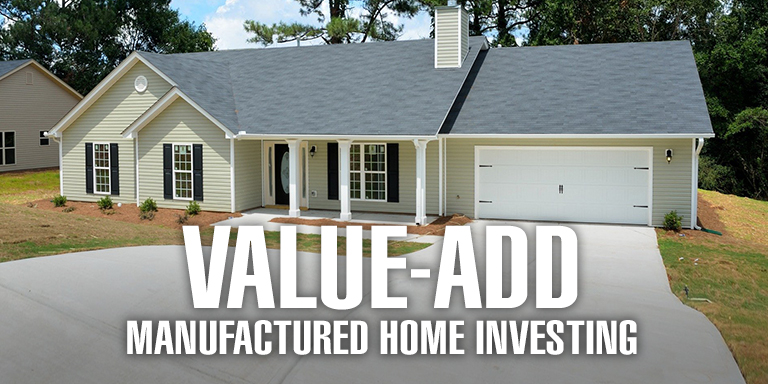Andrew Keel from Keel Team stumbled by accident onto the manufactured home niche. While looking for wholesaling leads, he found a willing seller with 2 mobile homes that he purchased for $2200 cash. Intending to wholesale them like he’d been doing, he posted the units on Craigslist and had over 25 interested buyers in 2 days. That’s when he knew there was a huge demand in this niche.
For a while, Andrew wholesaled mobile homes just like he had for single family homes. It wasn’t until he met a park owner that explained the value of owning an entire park that Andrew sat up and took notice of the low overhead costs and consistent cash flow in a mobile home park. He learned that there are a lot of benefits in owning real estate versus owning personal property because you can leverage more with financing, but you can still enjoy depreciation.
Today, Andrew owns over 20 manufactured communities across the country, or about 1500 units in total. He takes under managed manufactured communities, plugs them into his system, and maximizes the net operating income. He creates more efficient operations, sells the empty mobile homes, and rents out the lots for unbelievable cash flow
THE OPPORTUNITIES IN MOBILE HOME PARKS
The stigma about investing in mobile home parks definitely catches investors off guard at first. But that hesitation is holding them back from some incredible opportunities. During Covid, Andrew has collected 95% of his rents, so he feels pretty confident that this is not only a recession-proof niche, but also a pandemic-proof niche.
In this asset class, about 90% of the properties across the country are owned by aging mom-and-pop operators. They’ve owned the properties for 20-30 years, and they usually own them outright. Since they’re older though, they’ve let maintenance slide, and occupancy is usually around 60-70%. Still, they’re making boatloads of money.
It’s the perfect chance for a younger investor who’s hungry for growth to come in and buy the mobile home park to make value-add improvements on it. By improving the aesthetics of a park and filling occupancy to 100%, an investor can really improve the value of these assets. And a mobile home park has one of the highest asset classes for NOI growth opportunities which is so hugely important in making an investment successful.
WHAT VALUE-ADD LOOKS LIKE IN A MOBILE HOME PARK
Andrew recently bought a property in Fort Wayne, Indiana. Like a lot of parks, the owner was older and had retired to Florida. As a long distance landlord, the owner couldn’t keep up on regular maintenance and had let the park dwindle down to half of its possible occupancy.
Similarly to how we do value-add for apartments, Andrew can easily tackle some cosmetic upgrades that will immediately improve his properties. For $3,000-4,000, he can replace the flooring and paint in the existing units, and he can then turn around and sell the homes for $5,000-10,000 and start collecting the monthly lot fee from the tenant. Additionally, bringing lot rental fees up to the market rates is another quick adjustment that yields an immediate ROI for him.
In a different property that’s almost completely full and in excellent condition, Andrew takes a different tactic. The previous landlord included water in the lot rent, so a lot of unit owners washed their cars or pets at home or were just careless about their water consumption. Installing individual water meters at each lot pushed the utility bill back on the owners, and decreased the entire park’s water consumption by 30%.
HOW TO FIND MOM-AND-POP SELLERS
You can find mobile home parks through commercial brokers, or through traditional marketing methods like yellow letters or cold calling. Andrew prefers working directly with the sellers if he can. Between competition with other investors and just the fragmented nature of having to search out each individual owner, finding properties can create a bottleneck in the deal flow. If you’re going to pursue this niche, focus on the deal flow first.
Andrew’s criteria for properties are ones that have 50 or more lots, and that are located on a city’s utility grid. With a larger park, you’re just able to scale more quickly, and Andrew’s system is all about scaling quickly. That’s why he’s been able to grow so fast in four years.
Some of the mobile home parks are 50 years or older and they might have been passed from generation to generation. It’s possible that they’re not even connected to the city water or sewer systems. While a park that has a well and septic system isn’t a hard no for Andrew, replacing the utility infrastructure in an aging mobile home community could wreck all of his profit. And again, he’s looking for those aging owners who are ready to truly retire and leave behind their real estate portfolio as they move down to Florida.
CONCLUSION
It’s no secret that mobile home parks are collection-based businesses. With a large majority of his tenants on Social Security or SSI, even during a pandemic, the rents still get paid at the same steady pace of 95%. That speaks volumes about how this asset class can perform during downturns. If you’re ready to diversify into something new, the opportunity is huge in the manufactured home community.
Be Daring,
Josh
WHAT ARE YOU THINKING?
Every business—no matter how small or how large—can benefit from professionally-created videos and digital marketing tools. Have you had success with videos? Or are you looking to learn more about the process? Let us know below.

